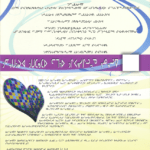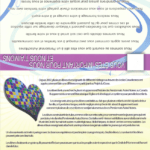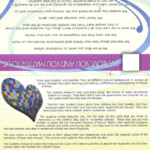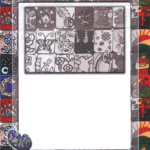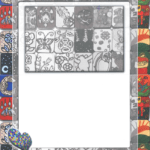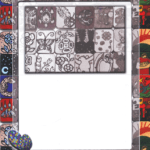Project of Heart is an innovative educational tool kit designed to engage students in a deeper exploration of indigenous traditions in Canada and the history of Indian residential schools. It is a journey for understanding through the heart and spirit as well as facts and dates.
Indigenous concepts of education and literacy, such as Grandmother and Grandfather teachings and reading the environment, are fully incorporated into the curriculum. Elders from First Nation, Métis and Inuit communities become regular participants in classroom presentations and discussions. Students lead many of the project outcomes, demonstrating their learning through videos and multimedia presentations and decorating small wooden tiles. Each tile becomes a meaningful artifact, representing one of the thousands of young lives lost due to the effects of the Indian residential schools system.
A key objective of the program is to encourage “ownership” of this historic injustice by enacting gestures of reconciliation for the past and continued oppression of First Nation, Métis and Inuit people in Canada. Project of Heart continues to be shared with elementary, secondary, and post-secondary schools in other regions of Canada.
Start your Project of Heart journey below.
INVESTIGATION INTO THE HISTORY AND LEGACY OF INDIAN RESIDENTIAL SCHOOLS IN CANADA
To get started, you and your learner group will begin an inquiry into the history and legacy of the Indian Residential Schooling system in Canada. This will be a life-long journey, as we are always learning.
The following questions can act as a guide to assist you in this step:
- Who went to Indian Residential Schools in Canada?
- Who set up the Indian Residential Schools in Canada?
- What organizations?
- Who were key people in the development of the system?
- Why were Indian Residential Schools established?
- What was the goal of the government?
- What were the goals of the churches involved?
- When did Indian Residential Schools operate in Canada?
- When did the first one open?
- When did the last one close?
- What are some of the significant dates in the IRS period?
- What happened to the children who attended Indian Residential Schools?
- Did every child have the same experience?
- What do survivors have to say about their own IRS experience?
- How did this affect parents and families?
- How did this affect communities?
- Did the impacts end when the children came home?
- Where were Indian Residential Schools set up in Canada?
- What were the locations of the schools?
- How many were set up in each province and territory?
- Were they located close to the children’s homes?
- Were the schools in the south the same as the schools in the far north?
The next part of Step 1 includes your learner group choosing a former Indian Residential School that was located near to where you live. This allows you, and your learners, to begin to understand how the people who lived on the territories that you live on today were impacted.
The following questions can act as a guide to assist you in this step:
- Where was this Residential School located?
- What are the years that this Residential School was operational?
- What church or other organization operated this Residential School? Did it ever “change hands” and become operated by a different organization? If yes, what years was it operated by each church or group?
- Upon whose traditional territory was this Residential School built?
- Where did the children come from to attend this Residential School?
- What were the conditions like at this Residential School?
- What were the impacts on the children who attended the schools?
- Find stories specific to this Residential School (these could come from survivor testimony, films, dvds, newspaper articles, reports, books, memoires, etc).
- What are some stories that survivors have bravely told about their experiences at this school?
- What do we know about this former Residential School today? Has the community announced any findings of unmarked graves?
LEARNING FROM THE FIRST NATIONS, INUIT, AND/OR MÉTIS NATIONS, COMMUNITIES, AND PEOPLES WHO LIVED ON THE LANDS WHERE THE RESIDENTIAL SCHOOL WAS LOCATED
In this step, your learner group learns about the Nation(s) on whose land the residential school stood or stands. What can we learn from them about the land, their ways of life, the contributions of their nations and people. This step focuses our attention on the fact that the people impacted by residential schools were human beings. They were living their lives, raising their children, governing their nations, and living in relation with the land, sky, waters, and animals around them. What can we learn from them?
Click on the TRC map below and find an IRS near your location.
The following questions can act as a guide to assist you in this step :
- Learn about the languages and cultures of the people who had their traditional territory imposed upon for the building of this Residential School.
- What are the knowledges, beliefs, and ways of living that the people of the territory had before they were colonized?
- How do the Indigenous people of the territory live now? How have they reclaimed their traditions, languages, and cultures? How do they continue to resist government and/or corporate oppression?
- What can you learn from them about living in balance with the land, animals, water, and sky?
- How did the people of this territory resist the government’s policies and laws? Research the contributions or achievements made by people or persons from this Nation’s traditional territory. This can be an individual from the past, or a living person who is demonstrating their resilience and achievements, in spite of systemic hardship. Examples have included activists, actors, athletes, musicians, performers, architects, politicians, scholars, lawyers, writers, journalists, etc. Prepare a presentation, poster, etc. about this person and share with your school or community. You can consult a list of names here.
CREATE A GESTURE OF RECONCILIATION
- Commemorative Wooden Tiles
- Feather Wreaths
- Create a Song
- Make a Video
- Totem Pole
- Other Gestures
Commemorative Wooden Tiles
From the beginning of Project of Heart the first act of reconciliation has been the decorating of small wooden tiles that have been installed in various commemoration exhibits across Canada. In the beginning the tiles were colored black on the edges as memorials for children who died in Indian Residential Schools. Later in the evolution of Project of Heart some participants chose to color the sides of the tiles with a color other than black to honor survivors and their families. If you would like to create tile exhibits, click here to find the instructions on decorating commemoration tiles. For more information about purchasing wooden tiles for your school or organization, please follow this link to Junction Gore, a Canadian supplier in Ottawa.

Many classes and learner groups have created their own commemoration exhibits with tiles and installed them within their classroom, school, or any other establishment in the community that would be appropriate. Not only are these installations beautiful to look at, they serve to honour former students of Indian Residential Schools and inspire people to do their own learning about Canada’s Indian Residential School system. Below are some examples of what three different schools composed with their decorated tiles.
----------
Feather Wreaths

Elder Dakota Eaglewoman worked with youth in Calgary to create these beautiful feather wreaths to honor children who attended Indian Residential Schools across Canada. Dakota created a feather template and copied it on paper for the youth to decorate. They chose the National Day of Healing and Reconciliation logo as the circle for the centre of each wreath. The youth wrote the name of the province across the centre logo and then decorated a feather for the children who attended each IRS in that province. Some provinces had 2 wreaths as there were so many residential schools that all of them could not fit on one wreath. On the quill of each feather the youth wrote the name of the residential school to identify the children that attended there as the ones being honored by the particular wreath. Each feather was then given unique decoration to honor the children.
----------
Create a Song
Perhaps your group prefers to express themselves musically? April Waters and her grade 4/5 students came together, with the help of singer/song writer Harmony Parent, to compose the song “Residential Wreck”. This song is an interpretation of the student’s learning, and is a reflection of the experience that survivor Victoria Elaine McIntosh shared in their classroom in Step 4 of Project of Heart. Give the song a listen and inspire your group to create their own piece! Click here to read more about their writing experience in their blog post.
----------
Make a Film/Video
I Promise from Shaughnessy Park.
More and more students are utilizing their technological skills to express their learning and to inspire others. This is also true for Charlene Kantyluk and her grade 8 students from Shaughnessy Park School in Manitoba. After conducting a full investigation in to the history and legacy of Indian Residential Schools the group knew that they needed to do more than tiles. Students and staff members pulled together to create a video to share what they learned, their wishes, their apologies and their promises. Use this video as an example to guide your reconciliation film-making experience! Click here to read this group’s blog post.
----------
Totem Pole
The story of how a unique Gesture of Reconciliation came to be created:
My name is Susanne Moskal and I am a grade 9 teacher from Langdon School in Alberta. My students have spent the last few weeks working through Project of Heart. What an incredible project! This had a huge impact on myself and all of my students. We prepared our Gesture of Reconciliation and presented it an elder (residential school survivor) that visited our class. It was such a touching and powerful moment. My students put together the attached Powerpoint (below) to explain our project and showcase pictures of what we created.
----------
Other Gestures
These are examples of gestures of reconciliation that have not been inspired by Project of Heart but are outstanding ways of creating awareness, honoring survivors, memorializing those children who were lost and efforts to bring about healing and reconciliation.
Remembrance Ceremony
 Students in grades 4-6 from Strathcona Tweedsmuir School gathered on May 22, 2013 to memorialize those children who died at Dunbow Industrial School. One by one they read aloud the names of children buried in this grassland graveyard. To conclude their ceremony, they all released butterflies to honour the children who lost their lives. Read the article, In a grassland graveyard, pupils pay tribute to Alberta’s long-lost native children by Dawn Walton (The Globe and Mail, May 22, 2013).
Students in grades 4-6 from Strathcona Tweedsmuir School gathered on May 22, 2013 to memorialize those children who died at Dunbow Industrial School. One by one they read aloud the names of children buried in this grassland graveyard. To conclude their ceremony, they all released butterflies to honour the children who lost their lives. Read the article, In a grassland graveyard, pupils pay tribute to Alberta’s long-lost native children by Dawn Walton (The Globe and Mail, May 22, 2013).
SURVIVOR VISIT
Once your group has finished their research and have decorated all of the tiles provided it is time to invite an IRS Survivor to visit your class or group to share his/her own experiences with the learner group. If you have an First Nation, Métis and Inuit staff member, parent or student in your group that can help to explain the cultural protocol of inviting someone to share their knowledge, experience and wisdom it is best to have that person(s) talk to the group about how a person should be invited and how group members should conduct themselves during the visit.

If you do not have a First Nation, Métis or Inuit person within or working with your group the following basic guidelines can be followed:
-
- Contact the IRS survivor, in person is best but if that is not possible you can contact by phone, and ask if he/she could visit your class or group to share some of their own experiences regarding their residential school experience, life experience and any other teachings that they would like to share with the group. Let the person know that you would also like them to smudge the tiles (or follow whatever protocol for prayer that is their own cultural practice) and to pray over the tiles. ** Be sure to talk to the survivor about the age of the learners. It is very important that the stories presented are appropriate to the age and comprehension level of the learner group.
- If you are inviting the survivor in person present a tobacco offering at that time. If you are connecting by phone, have a tobacco offering ready to present, or have a learner group member present, when the survivor arrives. You will also want to have a small gift ready to present to your guest at the end of the visit when you, or a group member, thank the survivor for sharing their stories with the group.
- Have the room set up in such a way that the visitor can share their stories in a way that is respectful and feels safe for the survivor and the learners. A circle might be the best setting or having the guest in front and the learners, especially if they are young learners or if there is a large group, in a semi-circle on the floor in front of the guest. Have Kleenex ready and available as it may be difficult for some of the group.
- Prepare the learner group in advance to be sure that everyone treats the guest with the upmost respect and appreciation. This person does not have to share with others, but is doing so out of kindness and a desire to help others learn. This in and of itself is a huge gift from the guest to the group. Learners need to understand and respect this. Group members should be attentive, quiet, not interrupt, not talk to others during the presentation.
- Learners should have time to ask questions at the end of the survivor presentation. Remind learners that this can still be very painful for the survivor so they are encouraged to ask questions but to think about the questions and be sure to ask them in a sensitive and respectful manner. The survivor may also ask the learner group some questions during their visit, so learners should be prepared to respond if asked a question and not to just sit and not respond.
- Once the survivor is finished speaking he/she can be asked to smudge the tiles and pray. The tiles should be prepared in advance by being set out on a table or a tray or some other way so that they can be smudged and easily moved to where the survivor is sitting or standing. The group leader can ask the survivor if he/she wants people to sit or stand during the prayer.
- After the prayer is finished the group leader, or another member of the group, will thank the survivor on behalf of the entire group and present the small gift. Ideally, each learner should file past the survivor, shake his/her hand, and thank his/her for sharing.
- Food is an important of any Aboriginal ceremony or event. Even if the whole learner group doesn’t eat together at the end of the sharing, one or two people from the group should sit with the guest and offer a snack, some tea or coffee and visit a bit before the guest leaves.
- IMPORTANT NOTE: If you have a school counselor it would be advisable to have the counselor sit in on the session. It is also important to monitor the learners after the visit. Some people may be triggered or otherwise traumatized by hearing the survivor’s stories. Everyone is different and some people may be disturbed no matter how sensitive the speaker is to the age and comprehension level of the group members.
**If you are unsure about where to find a survivor in your area, please contact us at or .
----------
Survivor Cards
Building relationships based on truth is an important part of the Project of Heart process. A survivor card is a good way to express your own personal thoughts and feelings and to honor those who survived the Indian Residential School experience.
We invite you and your group to create survivor cards that will be shared with IRS survivors across Canada. You can complete the cards at the same time that you are decorating the tiles or creating your gesture of reconciliation. You can share the survivor cards with the survivor(s) that visit your group in Step 4 or you may wish to send them to the Project of Heart office to have them distributed to survivors.
You may create your own cards or scroll down to view and download the Project of Heart survivor cards and complete it according to the following instructions.
You will require a photograph of your group participating in Project of Heart to put into the card, a pen to write a meaningful message, and a glue stick to paste both a tile and the picture onto the card.

A) Open the Survivor Card and glue the photograph of your group in the rectangular space at the top of the card. (The faded tiles indicate where it should be pasted).

B) If you have ordered tiles to use in your Step 3: Gesture of Reconciliation, please decorate a tile then flip to the front of the card to glue a tile on the white square in the top left hand corner.
**NOTE: Survivor tiles must have different colored edges other than black. Black edges represent the children who lost their lives in Indian Residential Schools, and the colored edges are to honor the lives of those who survived.
If you are not using tiles for your gesture of reconciliation you can draw the picture or design right in the white space, directly on the front of the card.

C) If you have more cards than you have survivors to give them to, please send the remaining survivor cards to Project of Heart, 2 Craftsman Private, Ottawa ON K1Y 4W9
----------
Project of Heart Survivor Cards
Cards are available in Inuktitut, French and English. Click on an image below to view the outside cover or the inside of the card that best suits your survivor (a lightbox will open with the selected card). To download the card, right-click on the image in the lightbox and select Save Image As.
Some printing tips:
- Print the outside cover and the corresponding inside of the card that best suits your survivor.
- You can either print them back to back (on the same page) or separately and attach them together.
- When printing, remember to adjust the printer settings to “Fit to Scale” to keep the survivor card on one page.
SOCIAL JUSTICE ACTION
![]()
Action is the more important part of learning. If we don’t take what we have learned and apply it to our lives we have not respected the learning that our Elders and teachers have given to us. In Step 5 of Project of Heart we chose an action that will make things better in our communities and our society.
The learner group now has the task of selecting a Social Justice Action that they will participate in to help to bring about positive change in their school, their community, our country or our world. As you scroll down the list that we have provided below your learner group will select one or more Social Justice Actions to take part in. Learner groups may also develop their own Social Justice Action. Project of Heart is always excited to hear about, support and spread the word about new Social Justice Actions that learner groups are undertaking in their own way.
--------
The Haudenosaunee nation and the 1492 Land Back Lane movement: Today, multiple land defenders and allies are in court for blocking a development project that was not consented to by the nation. Stop the criminalization of land defenders! Respect Indigenous Peoples’ sovereignty over their lands and waters, and right to free, prior and informed consent! Stay informed on their Facebook and Twitter.
--------
The M’ikmaq nation and their treaty rights: Mi’kmaq fisherpeople are being attacked by settler fisherpeople, with the blessings of colonial authorities, for exercising their 1752 Peace and Friendship Treaties rights of fishing and harvesting for a moderate livelihood. Respect treaty rights! Stop the racist attacks on the Mi’kmaq people! Click here for ways to support M’ikmaq treaty rights.
--------
The Algonquin nation and the #MooseMoratorium: The Algonquin nation of Barriere Lake in La Verendrye park are blocking several access points to sport hunters – who often kill even female and baby moose for trophies and abandon the rest of the body in the forest – to protect the rapidly declining moose population. The government must stop issuing hunter permits! Respect the Algonquin’s sovereignty on their unceded territory, and apply their knowledge and care around the moose and everything on the land! Sign the petition. Follow their Facebook page for news, supplies needed, and actions to take etc.
--------
The Wet’suwet’en nation and its fight against pipelines: The Wet’suwet’en nation have been fighting for years against pipelines threatening their unceded territory and lives. Coastal GasLink (CGL) workers and the RCMP are illegally building and occupying unceded Wet’suwet’en land. They must leave immediately! Many ways of taking action and donating at tinyurl.com/ISOaction
--------
The Secwepemc nation and the Tiny House Warriors movement: Ten tiny houses are being built and placed strategically along the 518 km Trans Mountain pipeline route to assert Secwepemc Law and jurisdiction and block access to this pipeline. Respect Indigenous law, sovereignty and free, prior and informed consent! Close dangerous man camps! Stop racist violent attacks and criminalization of land defenders! Sign the petition: Liberty Mutual must stop insuring tar sands, incl Keystone XL, Trans Mountain and Line 3.
--------
The Rotinonhseshá:ka of Kanehsatà:ke: They object to the proposed archeological digs by the Municipalité d’Oka and Mayor Pascal Quevillon’s proposed construction of a new Parrish Hall/Cultural Center for the Municipalité d’Oka. Thrity years after Canada’s military attack on Kanehsatà:ke (the “Oka crisis”), we continue to support the Rotinonhseshá:ka of Kanehsatà:ke in their fight to secure their right to self-governance in the face of colonial oppression. Sign the petition and follow Ellen Gabriel on Facebook.
--------
7 Free Ways to Make a Difference: The Caring Society has 7 free Ways to Make a Difference (campaigns) for First Nations children and their families. The campaigns include Spirit Bear, I am a Witness, Jordan's Principle, Shannen's Dream, Touchstones of Hope, Many Hands, One Dream, and Indigenous Kids Rights Path. Learn more about these 7 Ways and how you can participate! For more information about campaigns and resources, go to the First Nations Child & Family Caring Society!
--------
Have a Heart – Get Involved – Spread the Word: The Have a Heart campaign invites individuals to support culturally based equity for First Nations children living on reserve. On February 14, Valentine’s Day, show your love, unity and compassion by engaging in respectful activities that support equity for First Nations children so that each and every child in Canada is treated fairly and can grow up happy. Take action! Together we can ensure that First Nations children and youth have a brighter future!
--------
Write a letter in support of the Algonquins of Barriere Lake: Urge the Federal Government to respect the traditional leadership selection process of the Barriere Lake Community and end its attempt to impose Section 74 Indian Act band elections. To write your letter, please visit their website.
--------
Winds of Change: In 2 steps and in 2 minutes, send an electronic letter to your provincial representative calling for implementation of Call to Action 62.i. In the words of Ellen Gabriel, "This is what you need to be teaching your children, your grandchildren, your great grandchildren. You need to be teaching it in your schools and you need to make it a priority." For more information on campaigns and resources, visit Kairos Canada.
Kairos Blanket Exercise: The Kairos Blanket Exercise will set Project of Heart into context–the Indian Residential Schools were only ONE of a number of actions that the Federal Government enacted to colonize and assimilate Indigenous peoples in Canada. Contact your local Kairos team so you can bring this exercise into your school, church, university, yoga group, any organization that wants to learn more of the truth of our county’s history.
--------
Justice for Indigenous Women: Project of Heart has birthed an organization called Justice for Indigenous Women. Participants are invited to take their decorated tiles created in part 3 of POH and use them to learn more about the systemic discrimination against Indigenous women in Canada.
Make a “witness piece”, a piece of jewelry made from your decorated tile, and wear it to give testament to the resilience of Indigenous peoples, despite the attempts at genocide carried by the colonial state. Participants will learn how to educate others through their art! They are then invited to enact any of the social justice actions on the website or go to Amnesty International.
--------
SHARE YOUR KNOWLEDGE AND EXPERIENCE
Once your group has completed all of the components of Project of Heart there are some final tasks that are very important to ensure that others learn from the great work that your group did.
- Prepare a blog for the Project of Heart website to share your group’s experience with the rest of the world. People are really interested to see what learner groups around the country are doing. The blog can be prepared by the teacher/group leader, or another member of the group. It should be sent along with a picture, video clip or other innovative way to share what you and your group came up with. You can e-mail the blog post and visual aid(s) to Project of Heart National. Also follow Project of Heart National on Facebook.
- Print, fill out, and send the survivor card to your visitor from Step 4.
- Remind learners that one of the main goals of Project of Heart is to bring awareness and to educate all Canadians about the true history of Canada so that such atrocities never happen again in this country. Encourage learners to contribute to this process by:
-
- Sharing their findings with other classes or groups
- Making presentations to community groups, organizations and businesses
- Talk to family and friends about what they have learned
- Keep learning and always seek the truth
We have compiled a list of resource materials for your use in Project of Heart. Please visit Project of Heart National for more information.
Thank you for participating in Project of Heart!

